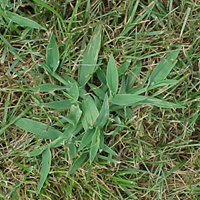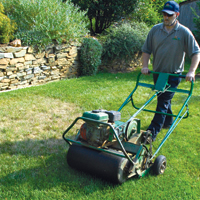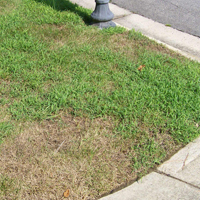You can get rid of crabgrass lawns and prevent this invader from taking hold or spreading in your lawn. Learn how to kill crabgrass from the lawn care experts at NaturaLawn of America. Read on.
The arrival of springtime means budding flowers, blossoming trees, and green grass. Unfortunately, with this abundance of new growth comes sprouting weeds as well. Crabgrass in particular is a weed that continues to frustrate homeowners year after year. By knowing how a weed grows and a few tips on natural prevention, you'll know what you can do about crabgrass without chemicals.
What Is Crabgrass?
Crabgrass is one of many broadleaf weeds that are distinguished by their wider blades when compared to lawn grasses. Crabgrass is also an annual weed whose seeds germinate during spring and summer. Germination begins when soil temperatures reach 55°- 65°F at a 3" depth for 5 consecutive days. Un-germinated crabgrass seeds can wait in the soil for up to thirty years before sprouting. Given the fact that a single crabgrass plant can produce 150,000 crabgrass seeds during the growing season, it's easy to see why controlling it is difficult.
Why Do I Have So Much Crabgrass?
Crabgrass favors sandy, compacted soil where the grass is in a weakened, thinned condition. Bare, thin lawns allow sunlight to directly hit the soil, which is an ideal condition for crabgrass germination. Remember, crabgrass seeds favor soil temperatures between 55° and 65°F. In addition, weeds thrive when your lawn has excess water and phosphorus levels. Learn more about summertime weed control from our experts.
How Can I Prevent Crabgrass?
The key to crabgrass prevention is to stack the playing field in favor of your grass; in other words, give it ideal growing conditions, and your grass will choke out weeds. Of course, you can make all the conditions favorable for turf-grass, but you also need to ensure you have the correct turf grass for your area. For example, bluegrass is a cool-season grass best suited for the northern US and won't thrive in southern states.
Providing ideal growing conditions for your grass is very important and can be accomplished in most cases with simple cultural practices including:
- Mowing
- Aeration and overseeding
- Fertilizing
Mowing Practices to Get Rid of Crabgrass
It's crucial to adjust your mower's height to allow your grass to grow to its optimal level. The principle behind this is straightforward: the higher your grass is above ground, the longer the roots are underground. This extended root system means there's less room for weeds like crabgrass to take root. Aim for mowing at a height of three inches or more. Taller grass blades not only provide the added benefit of shading the soil (thus keeping it cooler and making it less inviting for crabgrass seeds to germinate) but also create a robust turf environment where crabgrass struggles to establish itself.
Does mowing crabgrass spread it?
A common concern among homeowners is whether mowing crabgrass causes it to spread further. The truth is, if you mow after it has set seed, you may inadvertently distribute those seeds, encouraging its spread. However, mowing regularly before it reaches the seed-bearing stage can help prevent the weed from spreading and can also weaken the existing crabgrass plants.
Aeration and Overseeding: Dual Solutions for Crabgrass Control
A lush, thick lawn is not just visually appealing, but it's also your best defense against invasive weeds like crabgrass. Two highly effective lawn care practices to ensure such a lawn are aeration and overseeding.
What is Aeration?
Aeration is a process where small plugs of soil are removed from your lawn using an aerator. This has several benefits:
- Stress Relief for Grass: With more room to breathe and grow, grassroots spread out and grow deeper, leading to a healthier lawn.
- Improved Soil Health: By removing these plugs, you allow the compacted soil to loosen, facilitating better air exchange between the soil and its surrounding environment.
- Enhanced Water Absorption: Loosened soil means water penetrates deeper, ensuring that grassroots get the necessary moisture.
By breaking up compacted soil, aeration reduces the spaces where crabgrass seeds can germinate. Remember, crabgrass loves compacted, stressed-out lawns. An aerated lawn is not a friendly environment for crabgrass.
The Magic of Overseeding
Overseeding, as the name implies, is the practice of spreading grass seed over an existing lawn. When combined with aeration, the benefits multiply:
- Dense Turf Formation: Overseeding introduces new grass plants to fill in any thin spots in your lawn, making it harder for crabgrass and other weeds to establish a foothold.
- Vibrant Lawn Color: Different grass types have various color intensities. Overseeding with a mixture can result in a more vibrant, multi-tonal lawn.
- Resilience to Pests and Diseases: Introducing a mix of grass varieties can make your lawn less susceptible to specific pests or diseases that might target only one grass type.
When you overseed immediately after aeration, the grass seeds fall into the holes made by the aerator, providing them with an ideal environment to germinate and grow. This practice ensures the seeds are protected and have a direct path to the nutrient-rich soil beneath, helping them establish quickly and outcompete potential crabgrass germination.
Fertilizing to Get Rid of Crabgrass
Lastly, ensure your lawn's soil has the proper amounts of nutrients via a simple soil test. Soil testing will help you determine what compounds and nutrients your lawn is lacking so you can fortify your lawn with a natural fertilizer, which will correct any inequities.
How Can I Kill Crabgrass with Natural Lawn Care?
Don't give up if you've tried all the cultural practices and natural crabgrass controls we recommended above. If crabgrass is still giving you a headache — you still have options.
First, you can apply a pre-emergent fertilizer before the germination period to organically control crabgrass. If it is mid-summer and the crabgrass is already fully grown, you can wait it out and then attack in full force next season or treat it with an herbicide specifically labeled for crabgrass control. Spraying herbicidal weed control is always a last-ditch effort and should be done so with care. When using any type of control materials always follow label directions, and only spray the troublesome areas as opposed to treating your entire lawn.
You can control crabgrass with a pre-emergent or post-emergent herbicide. We advocate getting rid of crabgrass by chemical-free cultural practices. Knowing how the plant grows is key. Crabgrass is a broadleaf weed that thrives in specific soil temperatures and conditions. With this knowledge in hand, eliminating crabgrass is a matter of disrupting the conditions that the plant favors. You can achieve a healthy lawn free of crabgrass through diligent mowing, aeration & seeding, and fertilizing.
If you would like assistance with removing crabgrass from your yard, contact a local natural lawn care professional. NaturaLawn of America has provided homeowners with safer and effective, organic-based lawn care since 1987.










